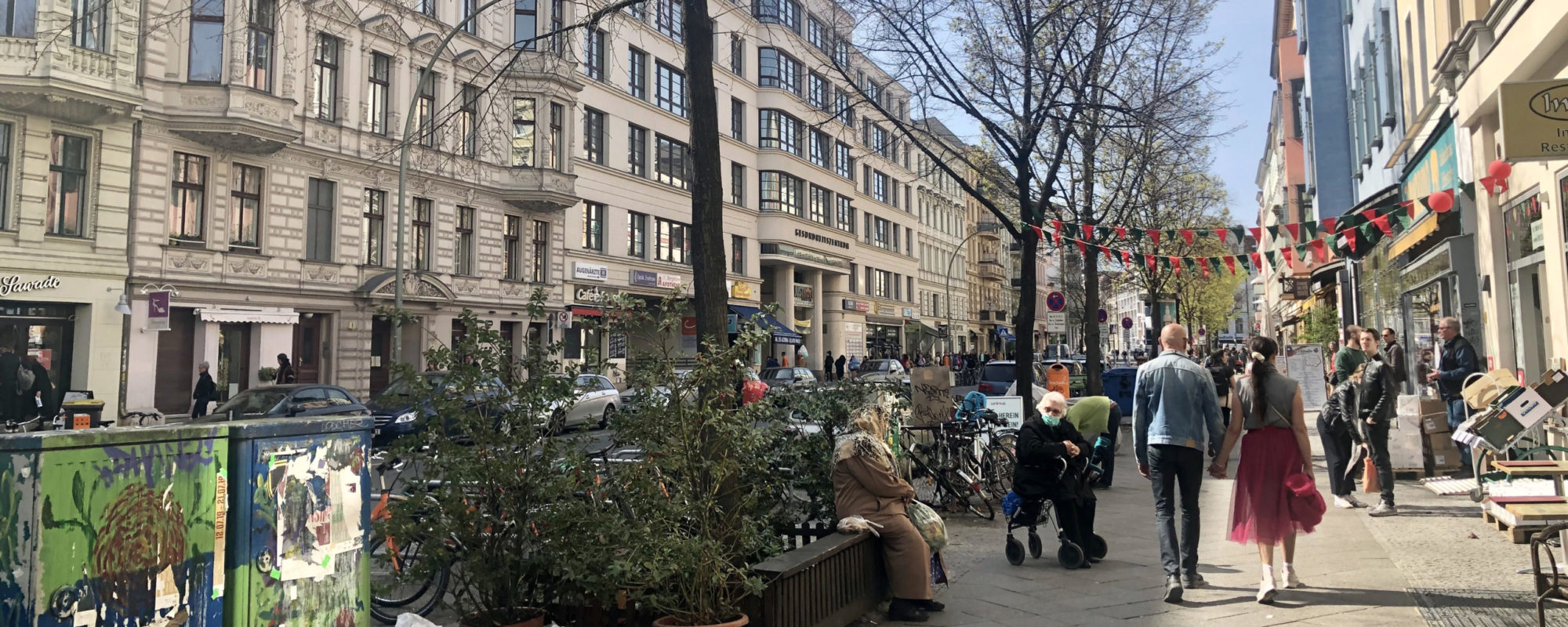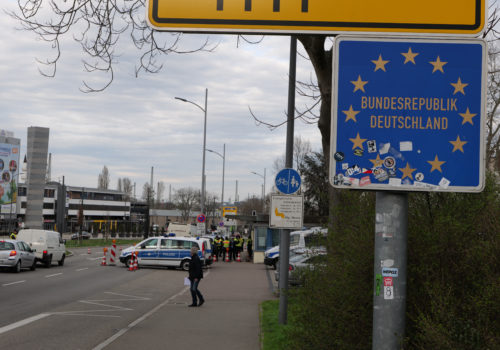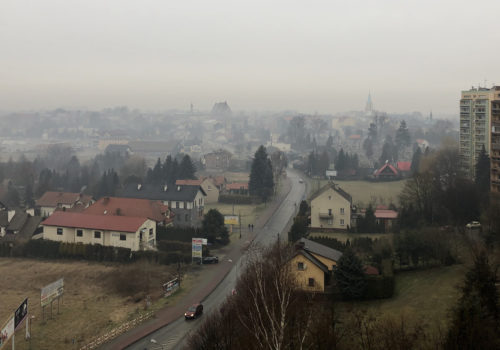BERLIN — On any afternoon on Berlin’s bustling Bergmannstrasse, one could be forgiven for believing it’s just a regular early spring day. The sun, finally warm, shines down on the Kreuzberg neighborhood street as passersby traverse the sidewalks; young children devour ice cream cones in front of the market hall as residents ride by on bikes or stop to get a bit of sun on one of the benches in the nearby square.
But subtle yet unmistakable signs betray the decidedly abnormal state of things. Outside the Edeka supermarket where I usually buy my groceries, a dozen or so people stand in line six feet apart from each other, some donning protective face masks; a guard posted next to the store’s sliding glass doors motions for people to enter in ones and twos as others exit.
Inside the store, far less populated than usual, runs a subtle but palpable undercurrent of tension: Although shelves are reasonably well-stocked, shoppers clearly want to get in and out as quickly as possible. Clerks manning the checkout lines are now separated from customers by tall, thick plastic dividers. (On the plus side, the normally long, slow checkout lines are shorter than I’ve ever seen in my nearly three years here; all situations, even pandemics it seems, have silver linings.)
Outside on the street, normally lively storefronts are shuttered. Bars and restaurants, which at this time of year normally begin spilling out onto sidewalks as the days grow warmer, have been closed for weeks. On the front door of each is some iteration of the message: Due to the coronavirus outbreak, we are closed indefinitely; we look forward to serving you again… sometime soon.
More than four weeks in, I—like millions of Germans and billions of people around the globe—have mostly adjusted to the new normal, and to the cognitive dissonance provided by a neighborhood that simultaneously feels so normal and yet has been undeniably transformed by the global pandemic. We’ve been under strict social distancing measures—Kontaktverbot, as it’s called in German—since March 23; gatherings have been limited to people in one’s immediate household, and nearly all aspects of public life have been put on hold. Some of my friends decamped to parents’ houses in other parts of the country; others are sequestered in their apartments in different neighborhoods across the city, right now as seemingly distant as friends in Paris or Vienna or San Francisco.
The sheet of printer paper my boyfriend Michael and I taped up on the wall to count the days we’ve sequestered ourselves in my 550-square-foot apartment—DAYS OF SOCIAL DISTANCING, I’d written across the top—now has 32 marks drawn onto it. When we first put up the sign, partly in jest, we figured it would never fill up. Now when we add a new tally each day we wonder whether the page will be big enough to hold the remaining lines that represent the duration of the crisis.
Although this unprecedented situation has been a massive disruption for all of us, I know I’m lucky: I have a comfortable apartment, a long reading list to fill the endless hours at home, enough food and even some new recipes to try out, and a partner to keep me company—not to mention good, public health insurance in a country with an excellent medical system. While I worry about my family and friends at home in the United States, things could be a lot worse.
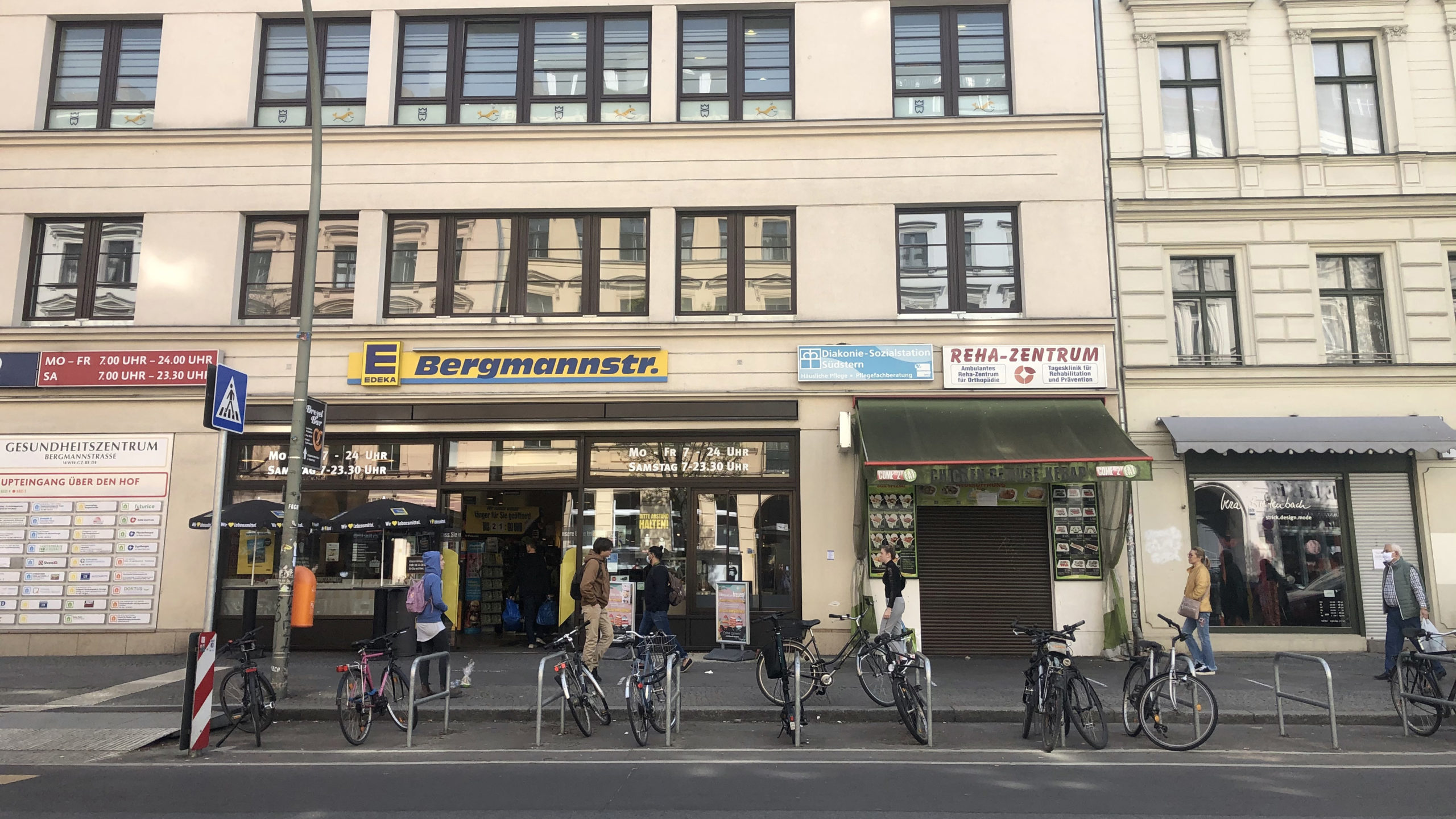
That’s in large part because Germany seems to be weathering the coronavirus storm better than many of its European neighbors or the United States. Though the country was hit early and hard with cases of the virus, its actions have been touted as an example of best practices for other countries to emulate—particularly when it comes to its effective, widespread testing.
As of Tuesday, Germany had more than 125,000 confirmed cases, approximately 4,600 of which are in Berlin, according to the Robert Koch Institute. Across the country, 2,969 people have died from the virus—a rate that’s received international attention since it’s significantly lower than those of other European Union members like Italy, Spain and France. And as of this weekend, the country has reached another milestone: there are officially more people who have recovered from the virus than those still ill.
As seems to be true elsewhere, the full extent of the coronavirus outbreak seemed to dawn on people gradually, including me. Germany recorded its first case on Jan. 27, a man in Bavaria who had interacted with a colleague visiting from China, but regular daily life continued far longer. By late February, I remember noting with amusement (and a small amount of alarm) that hand sanitizer, and then soap, seemed to be sold out everywhere; by then, many of us had already begun washing our hands upon arrival at restaurants or bars, and choosing to gather at friends’ homes more often than meeting somewhere outside.
But the problem escalated quickly in mid-March, by which point the situation in Italy had already become alarming. On March 8, Health Minister Jens Spahn announced that the federal government was recommending events larger than 1,000 people be canceled; a few days later, Berlin closed all bars and clubs. Merkel sounded the alarm the following day, saying in a speech that up to 60-70 percent of the population could be infected with the virus. Instead of handshakes, she encouraged people to greet each other by making eye contact “for a second longer” than usual.
Germany closed its borders on March 16, allowing only citizens, legal residents and those who commute across the border for work to enter the country. Non-essential businesses were shut down and people encouraged to socially distance as much as possible. And a few days later, for the first time in her nearly 15-year tenure as chancellor, Merkel gave a televised primetime address to the nation. Calling defeating the virus a “historic task,” she said: “This is serious. Since German reunification, no, since the World War II, there has not been a challenge for our country in which action in a spirit of solidarity on our part was so important.” The following Monday, March 23, the strict social-distancing measures we’re still under went into effect.
Maybe our biggest strength is the rational decision-making at the highest level… combined with the trust the government enjoys in the population.
Although it’s too early to make any definitive pronouncements, the results of social distancing and the high rate of testing seem to be effectively flattening the curve here. So what lessons can other countries learn from Germany’s response? My background in covering politics and populism hardly qualifies me as a public health expert, but a few things do stand out.
First of all, Germany had a handful of built-in advantages going into this crisis. Among them, its already quite capable health system has been tested but not yet overwhelmed by the virus. Its federal structure has allowed states and localities to act quickly and administer staggering numbers of coronavirus tests. And the country has benefited from Merkel’s competent, stable leadership. What’s more, many of the early infections here skewed younger than in Italy, Spain and other countries—partly because quite a few contracted the virus on vacation in ski towns like Austria’s Ischgl, where visitors tend to be younger and healthier than the overall population.
The advantages have been compounded by a testing rate seen in few other countries. In the final week of March, German health officials conducted more than 350,000 tests, around 50,000 per day on a population of 83 million. That figure has reportedly increased to half a million tests per week in April. That amounts to approximately 16 tests for every 1,000 people—twice the rate of that in the United States. Officials can combine the results with traditional contact-tracing methods, quickly identifying and isolating those who are likeliest to have been infected by friends or colleagues.
“Maybe our biggest strength in Germany is the rational decision-making at the highest level of government combined with the trust the government enjoys in the population,” Hans-Georg Kräusslich, the head of virology at University Hospital in Heidelberg, told The New York Times.
And then there’s the public’s overall willingness to comply with social-distancing guidelines. To the extent one can make such generalizations, Germans tend to be a rule-abiding people. During normal times, the simple act of crossing the street at a red light can bring an admonishment from an elderly woman or parents who tell you you’re setting a bad example for their children. As a result, people seem to be largely sticking to the new restrictions—and even seeking to report those who aren’t. (One somewhat humorous and revealing incident on that front: After Berlin first shut down bars in mid-March, police implored people to please stop calling in to tattle on nearby bars that had not yet closed. The sheer volume of such calls, it seems, had overwhelmed phone lines, impeding their ability to respond to actual emergencies.)
Now because of the promising trend in new cases and infection rates, there’s a feeling Germany could be at or near a turning point. Although Merkel insisted as recently as last week that it’s too soon to make any announcements about loosening restrictions, government officials said the Easter weekend would be decisive in its deliberations and will make further announcements this week about what comes next. Neighboring Austria has already begun slowly loosening its restrictions, allowing some smaller businesses to reopen this week, and there is hope Germany will soon follow.
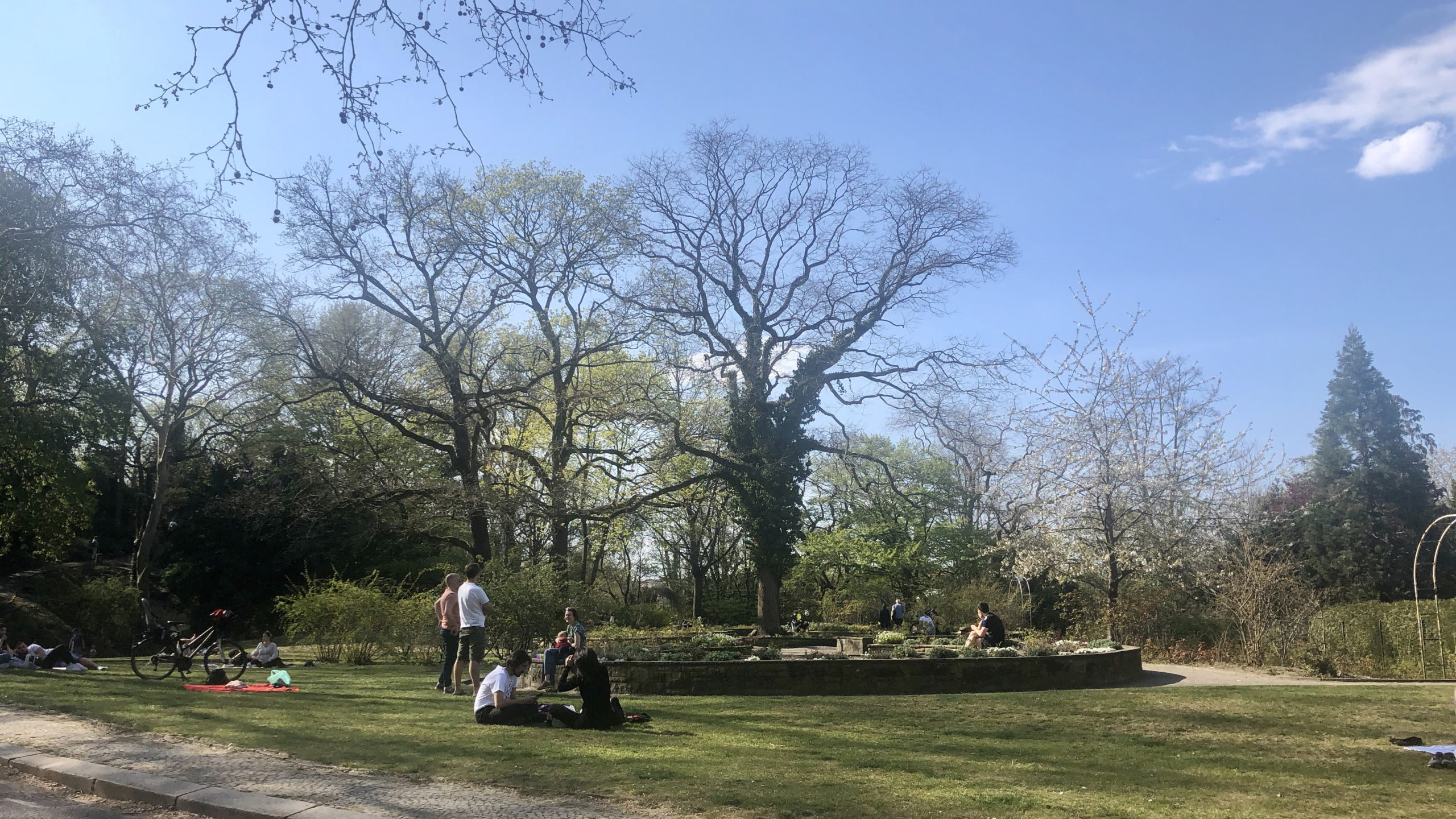
On Easter Sunday, we took a walk in Viktoriapark, a hilly green space down the street from where I live. It was another gorgeous day, the sun warming my shoulders as we climbed to the park’s highest point and looked out across the city. People lounged—six feet apart, of course—on blankets in the park’s broad fields. Between the trees covered in hints of bright green, Berlin’s iconic TV tower stood in the distance, shining in the reflected sunlight.
For a few blissful moments, I forgot we were in the midst of a global pandemic. My concerns—about my friends and family, the duration of this outbreak and its surely staggering aftereffects—slipped out of their persistent place in my thoughts as I allowed myself to briefly believe this was a normal spring day, and that my city and the world were again open for life and exploration.
Part of what makes the crisis so difficult to cope with, at least mentally, is the lack of a concrete end date in sight. As a distraction, I’ve been asking friends what they miss most, or to what they’ll most look forward when normalcy begins to return. Some who are self-isolating alone crave physical contact, just being able to hug a friend or sit next to someone; others, separated from their families, look forward to the day they’ll be able to gather again.
My desires on this front are simple. For some reason, I keep coming back to two things: Settling in for a journey on one of Germany’s high-speed trains and meeting up with friends in a Berlin biergarten. Travel and community are two things I’m lucky to normally have in abundance, and their absence has been glaring in these strange and unprecedented times.
Perhaps sometime soon, I’ll be able to board a train again, visiting some new part of the country to continue my research on the political shifts underway here (and begin exploring the new ones the pandemic may be causing). I may have to wear a mask and be hyper-conscious of what I touch and whom I come near, but I can handle that. Perhaps I’ll come back, drop my things at home and meet friends at Prater Biergarten in the Prenzlauer Berg neighborhood, one of my favorite places in the city. There may be fewer tables than in other summers, and the din of hundreds of voices may be a bit quieter, but that’s okay. I’ll take it.
When public life reemerges here and across the world, it will almost certainly be different than what came before. In the meantime, picturing that day makes the current state of things a little bit more bearable.

